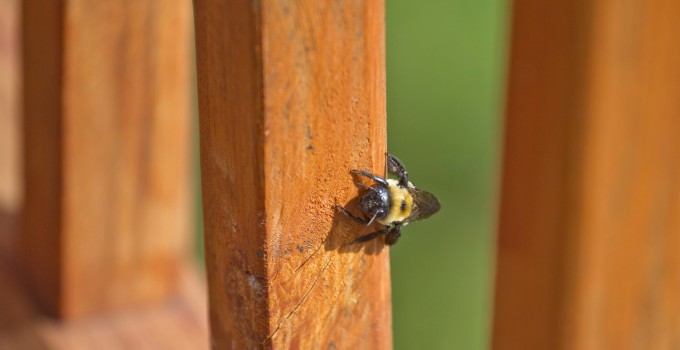When it comes to bees, our first instinct is usually to get as far from them as possible. It’s a common misconception that all yellow and black pests that fly are dangerous and looking to swarm and sting. Unlike yellow jackets, hornets, and some types of wasps, carpenter bees are not considered to be stinging insects. Their nesting behaviors are more closely associated with wood-destroying insects like carpenter ants and termites. If you’re worried about the large bees that are flying around your property or nesting on your home, you’ve come to the right place. Today, we’ll cover everything you need to know about carpenter bees and what you can do if they nest on your home.
What do carpenter bees look like?
Carpenter bees look similar to the common bumblebee without a fuzzy body. Their black and yellow color is very similar, but carpenter bees are larger with a shiny, black abdomen. They’re ½-1 inch long with a pair of wings that carry their clumsy bodies through the air. Unlike bumblebees, carpenter bees are solitary creatures, and they pose less danger to humans. Male carpenter bees look just as intimidating as female carpenter bees, but don’t have stingers. While flying around, carpenter bees aren’t very careful. They’ll bump right into you if you are in their path. For the most part, they’re harmless, but it’s not a good idea to swat at them in mid-air. A female carpenter bee has the capability to sting if provoked.
What does carpenter bee damage look like?
Carpenter bees get their name from their impressive woodworking. The queen carpenter bee will find a suitable nesting location, often along the eaves of your roof, your porch, or any wooden overhangs on your home’s exterior, and she’ll drill into it with precision, leaving behind holes in your home’s wooden elements. A carpenter bee invasion is easy to spot if you know what to look for. Evidence of carpenter bee nesting can be any holes in the wooden surfaces of your home that look like they were drilled out in an almost perfect circle. This is a tell-tale sign that you’re experiencing a carpenter bee invasion. One adult carpenter bee, along with their larvae, live in a single nest. However, it’s fairly common to find multiple nests in the same area if the area is unpainted or treated.
As carpenter bees tunnel through wood, they chew and spit out the wood instead of eating it like termites do. This can result in what looks like a mud splatter against your home below where the nest is located. For some, this manifests as stains on the side of their house below eaves and wooden shudders.
How can I stop carpenter bees from nesting in my home?
The best thing you can do to prevent carpenter bees from nesting on your property is to paint unpainted surfaces. Carpenter bees are attracted to exposed wood, especially wood that hasn’t been treated, painted, or stained. While this can’t provide 100% guaranteed prevention, it’s the best DIY strategy. A queen carpenter bee can bore a hole through finished wood if it’s her only option. Don’t delay! Carpenter bees won’t go away on their own. In fact, they will come back to the same nesting space year after year without professional intervention.
How can Seitz Bros. get rid of carpenter bees at my home?
Seitz Bros. provides carpenter bee prevention and removal services with our Home Protection Plan. This plan is the best choice for homeowners that want full year-round coverage for carpenter bees and other common household pests such as rodents, ants, cockroaches, stinging insects, flies, and centipedes. Call us or fill out the contact form on this page for a free carpenter bee inspection at your home!
How to Get Rid of Carpenter Bees in Your Scranton, PA Home Pest Control in Pennsylvania & New Jersey
Serving Northeast & Central PA | Lehigh Valley | Pocono Mountains | Western NJ

